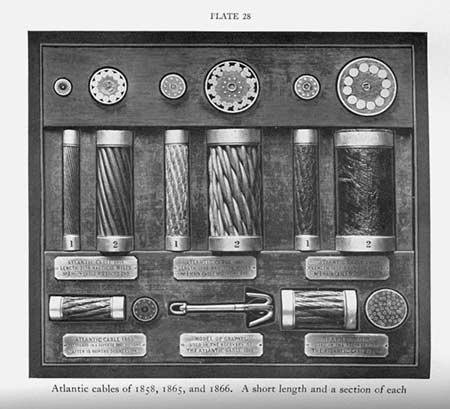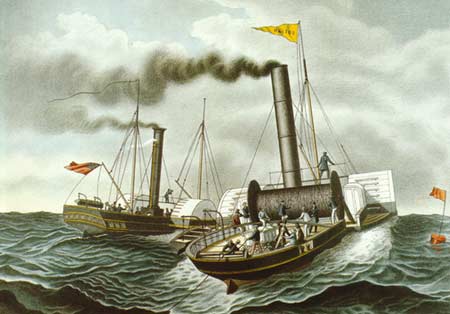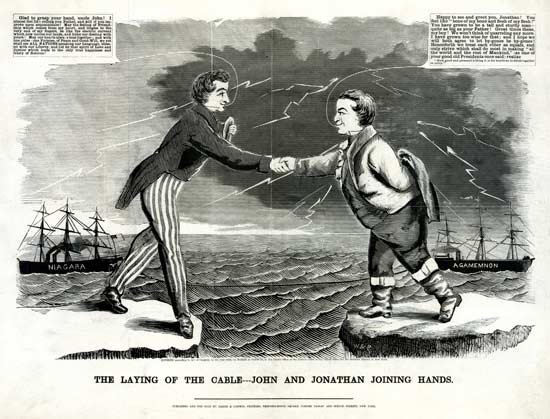By 1880 ninety thousand miles of mostly British cable lay on the ocean floor, a ninety million pound machine binding every inhabited continent, cutting across to Japan, New Zealand, India, through the West Indies, East Indies, and the Aegean. — Peter Galison.
1797 Submarine telegraphy proposed to the Barcelona Academy of Sciences by one Salvá, constructor of the first electric telegraph between Madrid and Aranjuez, a distance of 26 miles.
1803 Off the coast of Calais, Giovanni Aldini, a nephew of Galvani and professor of physics at Bologna, experiments with the subaqueous transmission of electricity.
1811 Samuel T. von Soemmering and Baron Pavel Lvovitch Schilling experiment with submarine telegraphy using insulated wire across the Isar (near Munich). The following year, Schilling uses a similar apparatus to explode mines across the Neva.
1813 John Robert Sharpe transmits signals through seven miles of insulated cable laid in his garden pond.
1838 Colonel Paisley, of the Royal Engineers at Chatham, experiments with subaqueous signaling using lengths of cable double-insulated with a layer of tarred rope encased in another layer of pitched yarn.

1839 O'Shaughnessy's Line, stretching across the Hugli River in India, is described in the Journal of the Asiatic Society.
1840 Apparently unaware of experiments by O'Shaughnessy and Paisley, Charles Wheatstone proposes to the House of Commons a detailed method for insulating a cable to be laid between Dover and Calais.
1842-43 Samuel Morse sends signals through insulated copper wire laid in New York Harbor. Proposes to establish telegraphic communication between the US and Europe by means of his method, which involves insulating the copper with hemp soaked in tar and pitch.
1844 Wheatstone successfully experiments with his own system in Swansea Bay.
1845 Ezra Cornell lays a 12-mile cable, consisting of two copper wires wrapped in cotton, insulated with india-rubber and enclosed in a lead pipe, between Fort Lee and New York. The wire works for several months, only to fail when the waterway freezes.
1846 Charles West receives permission to establish a submarine telegraph cable between Dover and Calais. Despite interest from such notables as Sir Joseph Paxton, original designer of the Crystal Palace, and Charles Dickens, the project languishes from lack of funds.
1848 In New York and Kiel, Armstrong and Siemens independently make trials of submarine telegraph cables insulated with gutta-percha.
1849 Aboard the "Princess Clementine," C. V. Walker successfully exchanges messages with London along a gutta-percha covered cable laid along two miles in the English Channel before joining an aerial line at the beach in Folkestone.
1850 Having secured cooperation from the French and British governments, the brothers Jacob and John Brett form the English Channel Submarine Telegraph Company. After arranging for the manufacture of twenty-five nautical miles of gutta-percha insulated copper wire, the Bretts test the wire underwater using a crude galvanometer (reportedly, on occasion, a person's tongue). In August, 1850, the Bretts install this cable, known as the First Channel Line, as Prince Albert looks on. Although messages are exchanged with, among others, Louis Napoleon Bonaparte, the line fails after being damaged by a fisherman.

1851 A second Channel cable is laid. This time, the cable's core comprising four copper wires, each insulated with two layers of gutta-percha and surrounded by tarred hemp followed by a sheathing of tarred yarn. Protective iron wires were then wrapped around the cable. The sturdy and resilient cable which resulted weighed seven tons per mile, and soon became the standard for submarine telegraphy. Meanwhile, the first submarine cable North America is laid across the Strait of Northumberland.
1853 Following three failed attempts, England and Ireland are finally linked by a submarine telegraph cable laid by the Magnetic Company. Another cable, with a high-capacity six-wire core, links Dover to Ostend.
1853-55 Submarine telegraphy develops quickly, linking England to many European countries; cables are laid, with varying degrees of success, between England and various Mediterranean destinations including North Africa, Malta, and Corsica. Meanwhile, Bright and Whitehouse pursue experimental research on electrical conduction in order to better understand why the lines so often failed and how these expensive failures could be prevented.
1855 The Black Sea Cable links Varna with Balaclava during the the Crimean War. The three-hundred mile line, which connected with a land-line to Austria at Varna, remained in service through the fall of Sebastopol, after which it failed and was not repaired.


1858 After two unsuccessful efforts, the first trans-Atlantic cable links England to North America over a distance of 2000 miles. The success is short lived for the cable breaks.
1859 Submarine connection of England with British India, through the Red and Arabian Seas, proves a failure.
1861 Successful installation of submarine telegraphic cable between Malta and Alexandria.
1865 Once the American Civil War ends Great Eastern attempt to lay a submarine trans-Atlantic cable, which breaks after 1200 miles.
1866 The Great Eastern's next expedition meets with success at last, and telegraphic communication begins on 27 July.
1870 The Red Sea cable links England to Bombay and Aden.
Bibliography
Bright, Charles. Submarine Telegraphs: Their History, Construction and Working. London, 1898.
Bright, Charles. "The Evolution of Telegraphy in the Victorian Era." Gentleman's Magazine. December, 1897.
Hunt, Bruce J. "The Ohm Is Where the Art Is: British Telegraph Engineers the Development of Electrical Standards." Osiris 9 (1993): 48-63.
Peterson, Walter. "The Queen's Messenger: An Underwater Telegraph to Balaclava." The War Correspondent: The Journal of The Crimean War Research Society 26.1 (2008): np. Reprinted here.
Smith, Willoughby. The Rise and Extension of Submarine Telegraphy. London, 1891.
Other Resources
Glover, Bill. "Atlantic Cables: 1856-2012" and " Cable Timeline: 1845-1900."
Last modified 22 November 2017